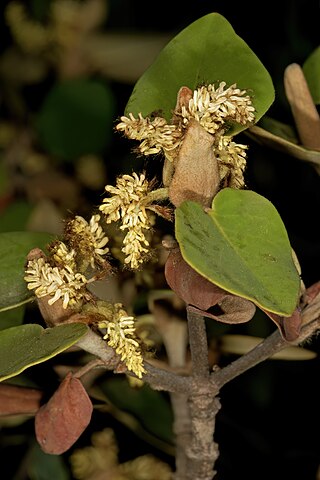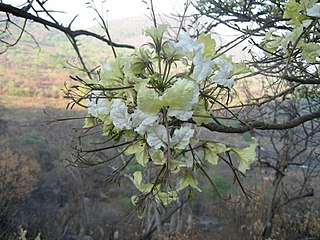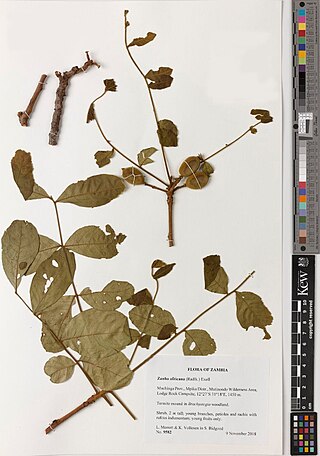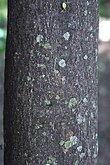
Androstachys johnsonii, the Lebombo ironwood, is a medium-sized Afrotropical tree species, and the sole member of the genus Androstachys in the Picrodendraceae. It is slow-growing, evergreen to deciduous, and dioecious, with flowers that are wind-pollinated. It is native to southeastern Africa and Madagascar, where it generally occurs gregariously on rocky hillsides, particularly in hot and dry situations. It produces a hard, durable wood which is of economic interest. Its specific name commemorates W. H. Johnson, a 19th-century Director of Agriculture in Mozambique. Four related species which are native to Madagascar, are usually placed in genus Stachyandra.

The Cleomaceae are a small family of flowering plants in the order Brassicales, comprising about 220 species in two genera, Cleome and Cleomella. These genera were previously included in the family Capparaceae, but were raised to a distinct family when DNA evidence suggested the genera included in it are more closely related to the Brassicaceae than they are to the Capparaceae. The APG II system allows for Cleomaceae to be included in Brassicaceae. Cleomaceae includes C3, C3–C4, and C4 photosynthesis species.

Pentadiplandra brazzeana is an evergreen shrub or liana that is the only species assigned to the genus Pentadiplandra, and has been placed in a family of its own called Pentadiplandraceae. It produces large red berries, sometimes mottled with grey. It is known from West-Central Tropical Africa, between northern Angola, eastern Nigeria and western Democratic Republic of Congo. The berry is sweet in taste due to the protein, brazzein, which is substantially sweeter than saccharose. Brazzein may be useful as a low-calorie sweetener, but is not yet allowed as a food additive in the United States and the European Union.

Millettia grandis is a species of plant in the family Fabaceae from South Africa. It is commonly called umzimbeet which is a name derived from the isiZulu name umSimbithwa.

Colotis antevippe, the red tip, is a butterfly of the family Pieridae. It is found in the Afrotropical realm.

Pinacopteryx is a monotypic genus of pierid butterflies found in Africa containing Pinacopteryx eriphia, the zebra white.

Belenois zochalia, the forest white or forest caper white, is a butterfly of the family Pieridae. It is found in Africa.

Capparis tomentosa, the woolly caper bush or African caper, is a plant in the family Capparaceae and is native to Africa.

Crateva kirkii, commonly known as the three-finger bush, is a small deciduous tree belonging to the Capparaceae or caper family. It ranges through eastern and southern Africa, including Kenya, Tanzania, Democratic Republic of the Congo, Malawi, Mozambique, Zambia, Zimbabwe, Eswatini, and KwaZulu-Natal province of South Africa.
Zanha golungensis, commonly known as the smooth-fruited zanha, is a species of plant in the family Sapindaceae that is native to Africa. It is used locally for timber and herbal medicine.

Cordyla africana is a tall, deciduous African tree with a large, spreading, much-branched crown, and a bole of some 2.2 m dbh. It is a member of the large leguminous family Fabaceae, and is known as wild mango in some areas. It is found up to 1,000 m (3,300 ft) elevation in large river valleys, in miombo woodland and coastal swampy evergreen forest, mostly on sandy soils, along the eastern parts of central and southern Africa. It occurs in South Africa in KwaZulu-Natal and Mpumalanga provinces, the Kruger National Park, Eswatini, Mozambique, Zimbabwe, Zambia, Malawi, Kenya and Tanzania. 'Cordyla' is from the Greek word 'kordyle', meaning a 'club' and is a reference to the club-shaped fruit and stalk.

Zanha africana, commonly known as the velvet-fruited zanha in English and as mkalya or mkwanga in Swahili, is a species of plant in the family Sapindaceae that is native to Africa. It is used locally for timber and herbal medicine.

Psychotria capensis, the bird-berry, is a southern African evergreen shrub or small tree. It belongs to a genus which is used medicinally in many regions, 'Psychotria' being from the Greek for 'rejuvenating', in reference to the healing properties of certain species. Kew lists some 2,000 species of Psychotria growing throughout the warmer regions of both hemispheres, but only two of them occur in southern Africa, namely P. capensis and P. zombamontana.

Goniocheton arborescens, commonly known in Australia as Mossman mahogany, is a small tree in the mahogany family Meliaceae. It is native to rainforests of Malesia, Papuasia, Queensland and nearby islands.

Maerua angolensis is a 10m tall, occasionally deciduous tree of the Capparaceae or caper family, often growing on termitaria and in thickets fringing seasonal watercourses, up to 1800m. Though never common, it is widespread in tropical Africa and arid regions, being absent from high-rainfall regions.

Pterocelastrus echinatus is a small Southern African tree occurring in South Africa, Mozambique, Zimbabwe, Eswatini, and Malawi. This species is found in montane and submontane evergreen forests, forest margins, rocky hillsides, and kloofs, growing between 600 and 2400 m above sea level.

Cadaba aphylla ("Swartstorm") is one of the many species in the genus Cadaba. It is indigenous to southern Africa.

Boscia foetida, commonly known as the stink shepherd's tree and the smelly shepherd's bush, is an evergreen shrub or tree that is native to the warmer and drier parts southern Africa. It is found in semi-desert and arid bushveld, and in the west it occurs commonly in areas which are otherwise sparsely wooded. It is known for the particularly unpleasant smell of its flowers which appear during early spring, to which its specific name foetida alludes. Its freshly cut wood likewise has an unpleasant smell, and has traditional medicinal and magical uses, for instance as a protection against lightning. In central Botswana the village of Mopipi is named after this species.

Cadaba farinosa is a 2–8 m (6.6–26.2 ft) high evergreen shrub or small tree that belongs to the caper family. It has simple ovate leaves with entire margins, zygomorphic, spidery, greenish, yellowish, whitish or pinkish flowers, and is covered in powdery hairs or scales, particularly the younger parts. It can be found in a zone from Senegal to India between the desert and the savanna.

Crateva tapia, commonly known as toco, payaguá, naranjuelo, or beach apple, is a member of the genus Crateva, belonging to the family Capparaceae. It is native from Mexico through Central America into South America as far as south Brazil.

























